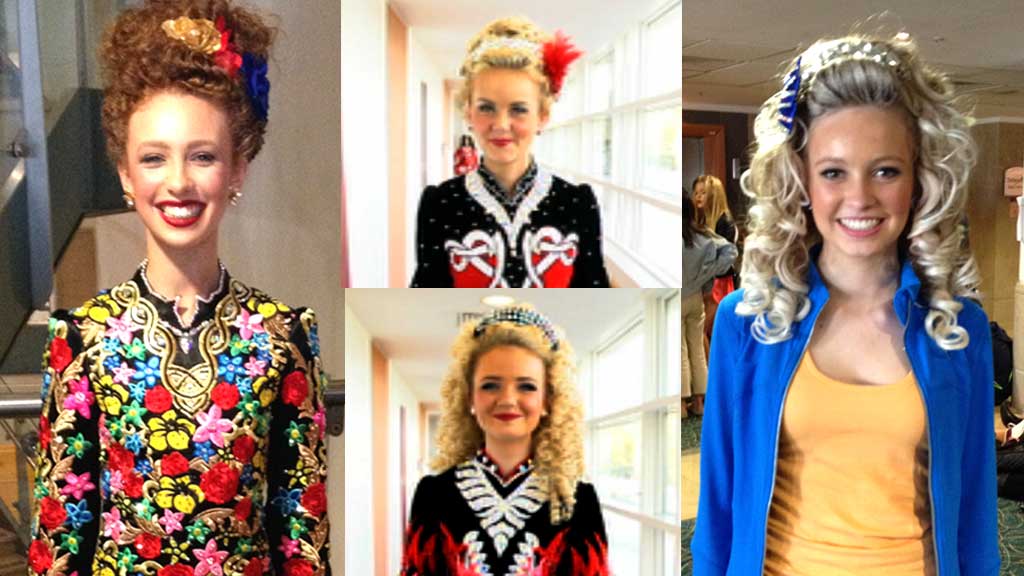‘It’s not all wigs & make-up’: Irish dancers come to London
One week after the Irish president’s visit, London is hosting the World Irish Dancing Championships. Channel 4 News delves into the world of wigs and jigs – and gets a few tips from the dancers.
Video: Eve Sheridan, (16, Galway), Simone Faloona, (16, Toronto) and Zoe Toland (16, Adelaide).
It may be the Irish dancing world’s biggest annual event. But at first glance, the words “Irish” and “dancing” don’t seem to apply.
Walking through the packed hallways of Paddington’s Hilton Metropole Hotel, there are a lot of different accents – and few of them are Irish. There are contingents here from as far afield as Australia, Canada, the United States, Slovakia and Japan.
And it is the bouncing wigs, not the dancing, that you notice straight away. Teens with tiaras, layers of make-up and mounds of (often fake) hair piled on top of their heads fill the corridors, squealing with friends or getting hushed pep talks from teachers: “Don’t stick your stomach out. Pull your elbows in.”
But make no mistake: they may be glamorous, but they are serious about the dancing. “I practice three or four hours a day, and then there’s class as well, which is three or four hours,” says Simone Faloona, 16, who has come all the way from Toronto, and has been dancing since she the age of three.
“I also train and run as well, because it takes all types of physical activity to do Irish dancing… you need to be fit.”

Photo (L to R): Amy Mae Dolan, from Belfast, Simone Faloona, from Toronto (top), Eve Sheridan, from Galway (bottom), Bella Sanders, from California.
The Riverdance effect
Ireland is hugely successful at bottling its national spirit and exporting it all over the world via millions of migrants. There’s the Guinness, the rumoured affable manner, the “craic agus ceol” – and the dancing. The Riverdance show of 1994 and its many spin-offs have a lot to answer for, making the stilted Celtic dance cool and inspiring youngsters to touch base with their Irish ancestory through their one-two-threes.
But there have been claims in recent years that as it has become more global, Irish dancing is moving away from its roots. The costumes have become more colourful, the skirts shorter and the sequins more sparkly. While the steps remain rooted in Irish tradition, competitors are expected to wear an inane smile and many wear fake tan.
The shimmering, colourful dresses are custom-made for the competition and tailored to fit. The most spectacular cost up to £1,600, and they are only worn for a few competitions before a new one is required. Most of the dancers are up from 5am on competition days so they have time to start the process of getting ready: from hair and make-up, to gluing their socks to their legs. And that’s before the physical stretches and preparation begin.
Don’t stick your stomach out. Pull your elbows in Teacher
Patricia Scanlon, who runs the Scanlon School of Irish dance in Birmingham with her sister acknowledged that dancing in 2014 has strayed. “Traditions change and you move with it,” she told Channel 4 News. “But for every child that’s dancing here with wigs and false tan, there’s 20 kids at home not doing that.
“It’s not all about wigs and make-up – we’ve got so much more. It’s making friendships, being in a team.”

And while it looks like a beauty pageant, those involved are not happy with the associations. On a forum for teachers and parents, one mother said a recent BBC programme Jigs and Wigs had portrayed the dancing as tacky and painted the dancing world in a similar light as My Big Fat Gypsy Wedding. Didi Sherian, from Galway, whose daughter Eve is competing, was keen to say the competitors are “athletes”. She told Channel 4 News: “They have physio, they have to train. It’s a serious undertaking.”
But after the years of intensive training, the most that these “athletes” can aspire to is to get a place in a national or global stage show. After Riverdance and Lord of the Dance, the current show doing the rounds is Heartbeat of Home. “Dancing in Heartbeat of Home would be the dream,” says Simone.
London Irish?
Along with the 5,000 competitors in this year’s championships, an estimated 25,000 relatives, teachers and fans are expected to have paid a visit to the Olympics of Irish dance, leading Boris Johnson to call the event a “vital boost to London’s economy”.
Traditions change and you move with it. But for every child that’s dancing here with wigs and false tan, there’s 20 kids at home not doing that. Patrician Scanlon
It is significant that the 44th contest is being held in the English capital for the first time. Irish migrants make up the biggest ethnic minority in Britain – and vice versa – but it is only now that the two countries have been given permission to be friends. The Royal welcome for President Michael D Higgins marked the first Irish state visit to Britain in 100 years and according to Mr Higgin, ushered in a “new era of friendships”.

Not that most of the dancers here are too worried about international relations. They will have had to qualify in regional and then national competitions before making it to the worlds – and these teenagers are focused on winning.
Like Zoe Toland, 16, who has made the trip from Adelaide in Australia with her mum (who has taken a month off work) her sister and around 200 teachers, family and supporters. She is part of Adelaide’s 100-strong Miller School of Irish dancing, and most of the dancers have some Irish heritage, “but not all of them, some just like it,” says Zoe.
“It’s actually quite big in Australia,” she adds. “I don’t think people realise how big it is all around the world.”